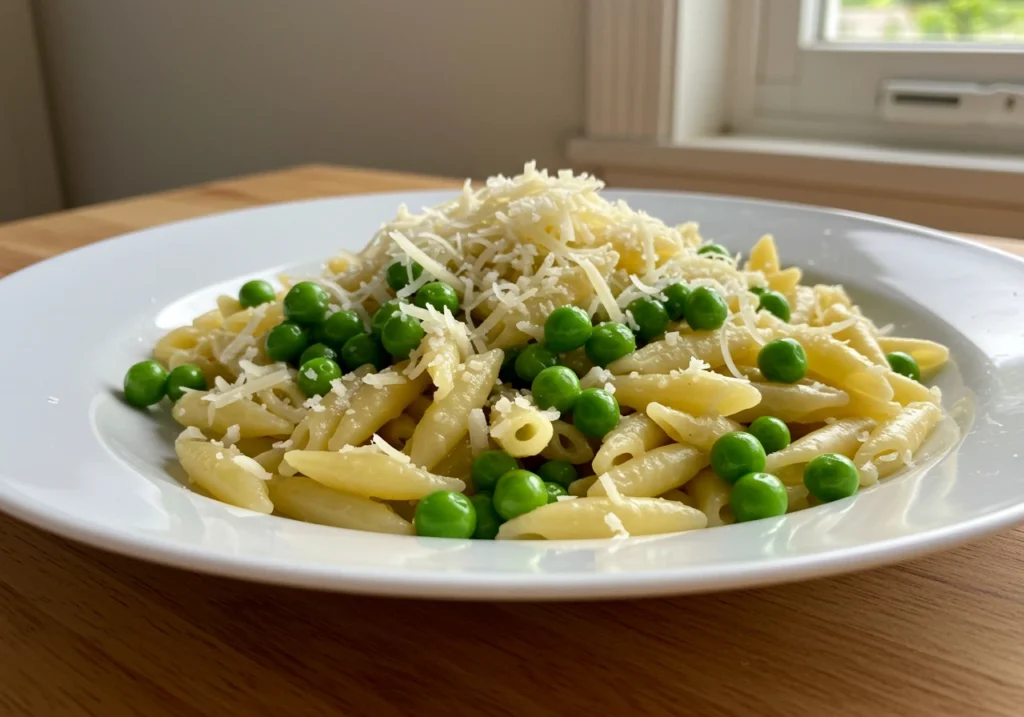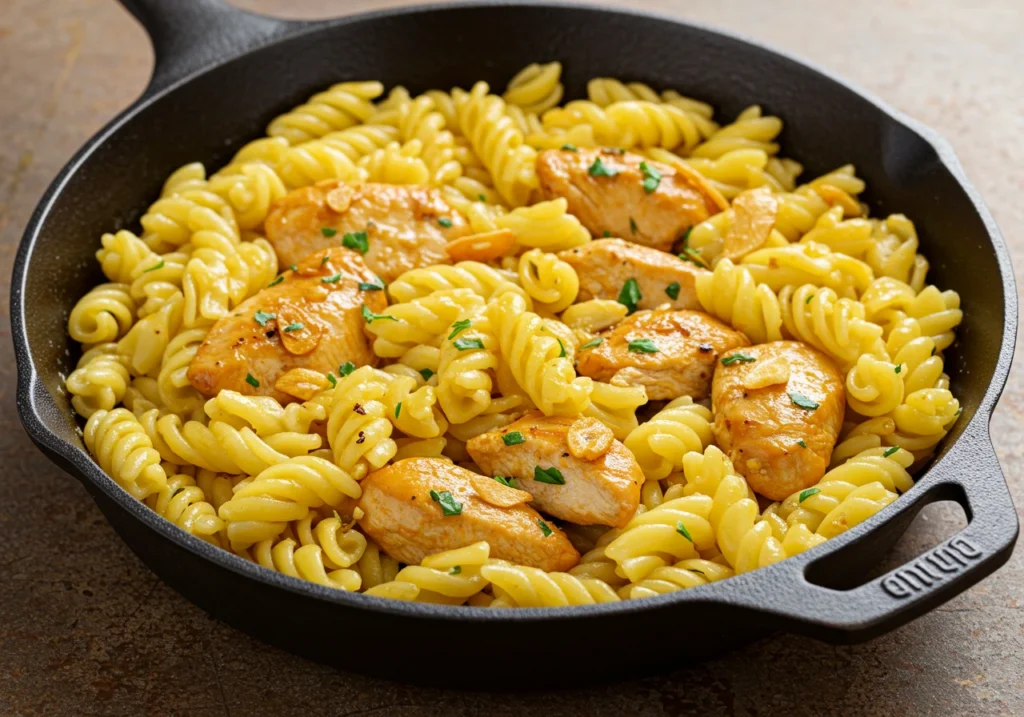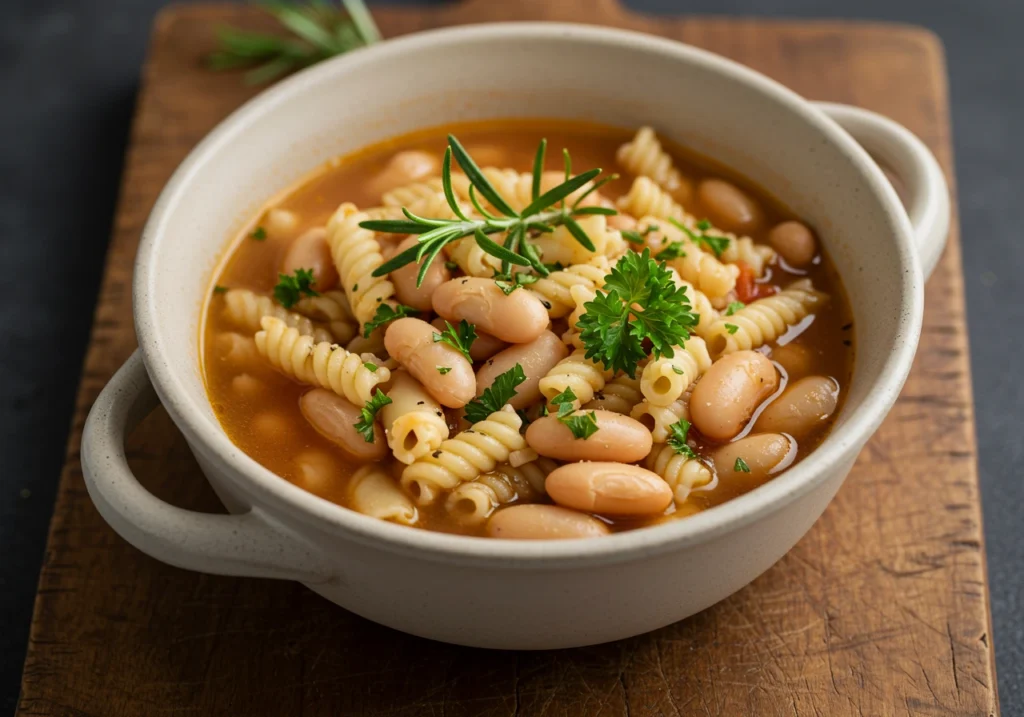Tried & True Ditalini Recipe: Creamy, Comforting, and Full of Flavor
Before we roll up our sleeves and dive into the delicious world of ditalini recipes, let’s set the stage. This hearty pasta is more than a supporting role in soups—it’s a star in countless comfort meals! Whether you’re chasing nostalgic Italian flavors or experimenting with one-pot wonders, ditalini brings bite-sized joy to every bowl. This guide isn’t just another pasta rundown—it’s a full-fledged flavor journey. I’ve tried several recipes myself, and oh boy, the textures and tastes are chef’s kiss! So if you’re ready to bring rustic charm into your kitchen, you’re in the right place.
Part 1: Introduction and Overview
Ditalini Recipe Origins: A Bite-Sized Culinary Classic
Ditalini, also known as “little thimbles,” hails from Italy, where every pasta shape tells a tale. Traditionally used in minestrone and pasta e fagioli, its short, tube-like form isn’t just cute—it’s practical. This pasta was engineered to hold onto broths, sauces, and chunky ingredients like beans or bits of veggies. It’s not trying to be flashy. In fact, its simplicity is its strength.
It’s the kind of pasta you turn to on a rainy day or when you need a belly-warming dish that doesn’t involve fancy ingredients. Trust me, when I first experimented with ditalini pasta recipes, I didn’t expect much. But one spoonful later, I was hooked. There’s something magical about how it soaks up flavors while keeping its gentle, chewy bite.
Moreover, ditalini has traveled far from its Italian roots. Today, it finds its place in modern fusion dishes, gluten-free versions, and plant-based bowls. So yes, it’s old-school—but it’s also wildly adaptable.
Why Choosing the Right Pasta Shape Matters
Believe it or not, pasta shape isn’t just about aesthetics. It can make or break your dish. Ditalini, in particular, is ideal when you need your pasta to blend into a dish rather than take center stage.
For instance, longer pastas like spaghetti tend to be the focus of a plate. Meanwhile, ditalini plays the support role beautifully—like a great bassist in a jazz band. It harmonizes with creamy sauces, chunky broths, and robust seasonings. And when it comes to one-pot recipes or weeknight meals? Game-changer.
Also, it’s a blessing for kids and picky eaters! My toddler actually loves it—probably because it’s easy to scoop and chew. And for adults? No slurping. No mess. Just perfect little bites bursting with flavor.
So before we jump into our first classic ditalini pasta recipe, remember: when texture and sauce-hugging ability matter, ditalini delivers in spades.
Part 2: Classic Ditalini Recipes
Comforting and Creamy Ditalini Dishes
Traditional Ditalini Pasta with Peas and Parmesan
Ingredients Required
To get started with this wholesome ditalini recipe, you’ll need:
- 1 cup ditalini pasta
- 1½ cups frozen or fresh peas
- 2 tablespoons unsalted butter
- 2 cloves garlic, minced
- ½ cup grated Parmesan cheese
- ½ cup heavy cream or half-and-half
- Salt and black pepper to taste
- Zest of ½ a lemon (optional for brightness)
- Fresh parsley or basil for garnish

These simple ingredients come together to create an incredibly comforting meal. This recipe was inspired by a rustic variation featured on Land O’Lakes, known for its creamy, dairy-forward texture.
Step-by-Step Cooking Instructions
- Bring a pot of salted water to a boil.
- Add ditalini and cook until al dente. Add peas 3 minutes before pasta is done.
- Meanwhile, melt butter in a large pan over medium heat. Add garlic and sauté until fragrant.
- Drain pasta and peas, reserving ½ cup of pasta water.
- Add cooked pasta and peas to the skillet. Stir in cream and Parmesan. Toss until silky, adding reserved pasta water to adjust creaminess.
- Season with salt, pepper, and lemon zest. Garnish with fresh herbs.
Tips for Achieving the Perfect Creamy Texture
You don’t need tons of cream. Add cheese off-heat (as recommended by FoodByMaria) and let residual heat melt it. Gradually add pasta water to emulsify. Use freshly grated Parmesan for best flavor.
Personal Experience
At first, I didn’t expect much from such a minimal recipe—but it’s truly addictive. The sweet peas and rich cheese make magic. It’s now a go-to family favorite.
Bold, Baked, and Cheesy Ditalini Creations
Ditalini with Roasted Tomato Sauce and Goat Cheese
List of Ingredients
- 1 cup ditalini pasta
- 2 cups cherry tomatoes
- 2 tablespoons olive oil
- 1 clove garlic, crushed
- ½ teaspoon red pepper flakes (optional)
- ⅓ cup crumbled goat cheese
- Salt and pepper to taste
- Fresh basil or arugula for garnish
Preparation Method
- Preheat oven to 400°F. Toss tomatoes with olive oil, garlic, salt, and pepper. Roast 20–25 min.
- Cook ditalini until al dente. Drain.
- Mix roasted tomatoes with pasta. Stir in goat cheese while warm.
- Top with herbs and chili flakes.
Flavor Profile & Pairings
You get bold sweetness from tomatoes, tang from goat cheese, and brightness from herbs. Perfect with arugula salad or grilled chicken.
Personal Insight
This dish feels elegant but is super simple. Try it with feta and olives for a Mediterranean twist!
One-Pot Cheesy Ditalini
Necessary Ingredients
- 1½ cups ditalini pasta
- 2 tablespoons butter
- 1½ cups milk or half-and-half
- 1 cup shredded cheddar
- ½ cup shredded mozzarella
- ¼ cup grated Parmesan
- ½ teaspoon garlic powder
- Salt and pepper
- Optional: chopped spinach or steamed broccoli
Cooking Process
- Melt butter in a skillet. Toast uncooked ditalini to boost nuttiness.
- Add milk, seasonings, and bring to simmer. Stir frequently.
- Cook pasta slowly in milk. Once tender, remove from heat.
- Stir in cheeses until creamy and gooey.
Advantages of One-Pot Meals
Only one pan—yay! Starchy pasta water thickens the sauce naturally. According to Delallo and Simply Recipes, one-pot methods enhance flavor and reduce cleanup.
Tips and Variations
This works with almond milk, added chicken, or even a dash of Dijon mustard for extra depth. It’s endlessly customizable!vates the whole dish. Sounds weird—but trust me, it works.
Part 3: Innovative Ditalini Dishes
Protein-Packed and Creamy Ditalini Creations
Garlic Parmesan Chicken Ditalini Pasta
Ingredient Breakdown
This modern ditalini pasta recipe blends comfort food with lean protein:
- 1½ cups ditalini pasta
- 2 chicken breasts, cubed
- 2 tablespoons olive oil
- 4 cloves garlic, minced
- ½ cup grated Parmesan cheese
- 1 cup chicken broth
- 1 cup heavy cream or Greek yogurt (lighter option)
- ½ teaspoon dried thyme
- Salt and pepper to taste
- Chopped parsley and chili flakes (optional)

Sources like Healthyish Foods and EatingWell highlight this recipe for its perfect flavor-nutrition balance.
Detailed Recipe Steps
- Cook ditalini in salted water until al dente. Drain and set aside.
- In a skillet, heat olive oil and cook seasoned chicken until golden. Remove and set aside.
- Sauté garlic in the same pan. Add chicken broth and simmer.
- Stir in cream (or yogurt), thyme, and Parmesan. Simmer until thickened.
- Add chicken and pasta. Toss to coat. Adjust seasoning and top with parsley.
💡 Tip: Try Greek yogurt for a tangy, lighter version—thanks to PoshPlate for that idea!
Nutritional Information
Around 450–500 calories per serving depending on your cream choice. It’s rich in protein, calcium, and healthy fats. Easy to adapt for dietary needs.
Personal Feedback
I followed a base from Recipes by Clare but added lemon zest for brightness. The result? Creamy, flavorful, and surprisingly quick. Great use of leftover chicken!
Plant-Based and Flavor-Forward Ditalini Dishes
Ditalini with Tender Herbs, Chickpeas & Yogurt
Components and Substitutions
- 1 cup ditalini pasta
- 1 can chickpeas, rinsed and drained
- ¾ cup Greek yogurt (or cashew yogurt for dairy-free)
- 1 tablespoon olive oil
- 1 teaspoon cumin
- Fresh herbs: dill, mint, parsley, cilantro
- Salt, pepper, lemon juice
No fresh herbs? Use half the amount of dried instead.
Cooking Instructions
- Cook ditalini in salted water. Reserve some pasta water.
- Sauté chickpeas in olive oil and cumin until golden.
- In a bowl, mix yogurt with a splash of pasta water, lemon juice, and salt.
- Combine pasta, chickpeas, and yogurt mixture. Add herbs and adjust seasoning.
This method from FoodByMaria keeps it creamy without feeling heavy.
Health Benefits
Chickpeas bring fiber and protein; herbs offer antioxidants and digestive support (Food52). Yogurt adds gut-friendly probiotics—a feel-good bowl!
Personal Observations
Tried this on a hot day—so refreshing! The crunchy chickpeas and herby tangy sauce were a hit. It’s light, nourishing, and perfect for summer.
Creamy Marry Me Ditalini Sausage Pasta
Ingredients and Their Roles
- 1½ cups ditalini pasta
- 8 oz Italian sausage (chicken or turkey optional)
- ½ onion, finely chopped
- 3 cloves garlic, minced
- ½ cup sun-dried tomatoes, chopped
- 1 cup heavy cream
- ¼ cup Parmesan cheese
- ½ teaspoon chili flakes
- Salt and pepper
- Fresh basil for garnish
Sun-dried tomatoes add bursts of sweetness and deep umami flavor.
Step-by-Step Preparation
- Cook ditalini. Reserve ½ cup of pasta water.
- Brown sausage in skillet. Remove and set aside.
- Sauté onion and garlic. Add sun-dried tomatoes.
- Stir in cream and simmer.
- Add sausage, pasta, Parmesan, and pasta water. Stir until creamy.
- Garnish with basil and chili flakes.
Serving Suggestions
Pair with garlic bread or a crisp green salad. For extra flair, top with pine nuts or balsamic drizzle.
Personal Experience
I was skeptical about the viral “marry me” trend—but ditalini turned this into a cozy, craveable hit. The sausage adds a punch, and the tomatoes bring the wow factor. Served it with kale salad and it was a weeknight win.
Part 4: ditalini recipe in Soups and Salads
Ditalini Pasta e Fagioli (Pasta and Beans Soup)
Traditional Ingredients
This heartwarming Italian staple combines pantry basics into a rustic bowl of joy. The ingredients are humble, yet the result is pure magic:
- 1 cup ditalini pasta
- 2 cans cannellini or borlotti beans (drained)
- 2 tablespoons olive oil
- 1 small onion, chopped
- 2 garlic cloves, minced
- 1 celery stalk, diced
- 1 carrot, diced
- 3 cups vegetable or chicken broth
- 1 can diced tomatoes
- 1 teaspoon dried oregano
- Salt and black pepper to taste
- Optional: red pepper flakes, Parmesan rind, fresh parsley

This recipe follows the authentic setup often featured on Allrecipes, where it’s known as a “hug in a bowl.”
Cooking Method
Begin by heating olive oil in a large pot. Add onion, carrot, and celery (aka soffritto) and sauté until soft and aromatic. Toss in garlic and cook for one more minute.
Next, pour in tomatoes, beans, oregano, and broth. Bring everything to a simmer and let it cook for about 15 minutes. Add a Parmesan rind if you have one—it adds deep umami.
Finish with a generous drizzle of olive oil, a sprinkle of Parmesan, and chopped parsley
Personal Experience and Tips for Enhancing Flavor
The first time I made this dish, I didn’t expect to fall in love. I thought it might be too simple. But wow—I was wrong.
The aroma alone, while the soffritto cooked down and the broth absorbed all the veggie sweetness, had the whole house hovering near the pot. I added a spoonful of tomato paste for depth and sautéed the herbs with the veggies instead of just tossing them in.
It’s now my go-to when I need comfort fast, especially on rainy days. Ditalini keeps everything spoon-friendly and satisfying, making it the unsung hero in this traditional treasure.
Part 5: Cooking Techniques and Tips
How to Cook ditalini recipe Perfectly
Boiling Time and Techniques
Cooking ditalini pasta may seem basic, but it’s one of those “simple but not easy” kitchen tasks. Because of its small, tube-like shape, ditalini cooks faster than larger pastas. A general rule? Boil for 8–10 minutes until just al dente.
Use a large pot with plenty of water. This allows the pasta to move freely, preventing clumping. Bring the water to a rolling boil before adding your ditalini—a crucial step for even cooking.
Tips to Prevent Overcooking
Ditalini can go from chewy to mushy in the blink of an eye. To avoid overcooking:
- Set a timer for 2 minutes before the package recommends.
- Taste-test early and often.
- Drain immediately once al dente, then rinse under cool water only if you’re using it in a salad or cold dish.
For soups, undercook slightly and add the pasta to the hot broth right before serving—it’ll finish cooking in the pot.
Importance of Salting the Water
This is non-negotiable. Salting your water well—think 1 tablespoon per 4 cups—is how pasta gets its first layer of flavor. Since ditalini is tiny and meant to absorb sauces and broths, seasoning early is essential. As chefs like to say, your pasta water should “taste like the sea”!
Pairing ditalini recipe with Sauces and Ingredients
Best Sauce Consistencies for Ditalini
Ditalini’s small size means it doesn’t do well with chunky, heavy sauces. Instead, it shines in creamy, brothy, or emulsified mixtures. Light tomato sauces, cheese sauces, or olive oil-based dressings coat ditalini beautifully without overpowering it.
Food & Wine recommends pairing ditalini with “velvety sauces that cling to each nook,” while PoshPlate.us also favors yogurt or herb-based dressings that add flavor without bulk. Food Network suggests tossing ditalini into soups, where its shape captures the broth like a charm.
Complementary Ingredients and Flavors
Looking to elevate your ditalini pasta recipe? Try pairing it with:
- Peas, carrots, or corn: sweet veggies that match ditalini’s bite-size nature.
- White beans, lentils, or chickpeas: great for plant-based meals with texture.
- Soft cheeses like ricotta or feta: melt in easily, creating creamy depth.
- Proteins like grilled chicken or ground turkey: lean and flavorful.
According to Simply Recipes, ditalini also does well in salads with crunchy greens and vinaigrettes. Meanwhile, Land O’Lakes recommends butter-based sauces or browned garlic for simple, rich flavor.
Making ditalini recipe Dishes Healthier
Substituting Ingredients for Healthier Options
Just because you’re indulging in pasta doesn’t mean you have to give up on nutrition. Try these swaps:
- Use whole wheat or lentil-based ditalini for more fiber and protein.
- Sub out heavy cream with Greek yogurt or cashew cream for a lighter, probiotic-rich base.
- Reduce cheese portions or switch to nutritional yeast for a cheesy flavor without the fat.
Incorporating Vegetables and Lean Proteins
When it comes to upgrading your ditalini dish, veggies are your best friends. For example, stir in spinach, kale, zucchini, or roasted bell peppers to add volume and vibrant flavor. To take it a step further, add grilled shrimp, tofu, or turkey sausage for a lean protein boost that doesn’t weigh things down.
Moreover, Food & Wine suggests blending cooked cauliflower into your sauce—it adds creaminess and extra nutrition without being detectable (a clever trick for picky eaters). Similarly, EatingWell supports this method as a smart way to “sneak” in more vegetables without compromising taste.

Personal Tips for Balancing Flavor and Nutrition
From my own kitchen experiments, I’ve found that a splash of lemon juice or vinegar brightens creamy dishes—no extra salt needed. And adding herbs like basil or dill gives your dish complexity without calories.
Also, cooking your pasta separately when making soups or salads helps avoid over-saturation and bloating—keeping everything fresh, tasty, and light.
Part 6: Frequently Asked Questions (FAQs)
FAQs About ditalini recipe
What can I do with ditalini recipe?
Oh, the possibilities! Ditalini pasta is one of the most versatile shapes in the pasta family. Its petite, tubular size makes it a star player in soups—especially in Italian classics like pasta e fagioli and minestrone. But that’s just scratching the surface.
You can use ditalini in creamy one-pot meals, veggie-packed pasta salads, or even as a base for hearty casseroles. It’s ideal when you want pasta that blends in rather than steals the spotlight—think stews, skillet meals, or baked dishes. Plus, it holds sauce beautifully, making it a winner for everything from cheese sauce to yogurt-based dressings.
What does ditalini mean in Italian?
In Italian, “ditalini” translates to “little thimbles.” The name comes from “dito,” meaning “finger,” and the diminutive suffix “-lini,” which implies something small or cute.
And honestly, the name fits perfectly. These tiny tubes look like miniature macaroni and are perfectly bite-sized—great for dishes where you want texture without overwhelming size.
What happened to ditalini recipe pasta?
Ah, the great “Where’s my ditalini?” mystery. Don’t worry—it hasn’t vanished off the face of the earth. But yes, at certain times, it can be oddly hard to find on store shelves.
Why Ditalini Pasta Might Be Hard to Find
Several factors might cause ditalini pasta to go MIA. For instance, supply chain issues, regional stocking choices, or even trends in home cooking can all play a role. During high-demand periods, like the pandemic, many folks turned to pantry staples such as pasta, and as a result, niche shapes like ditalini surged in popularity. Consequently, stores struggled to restock fast enough.
If you’re ever in a pinch, consider checking international or Italian specialty stores. Alternatively, you can order online for a wider selection. In addition, don’t be afraid to explore store-brand versions—they often carry this shape under names like “small macaroni” or “tiny tubes.”

